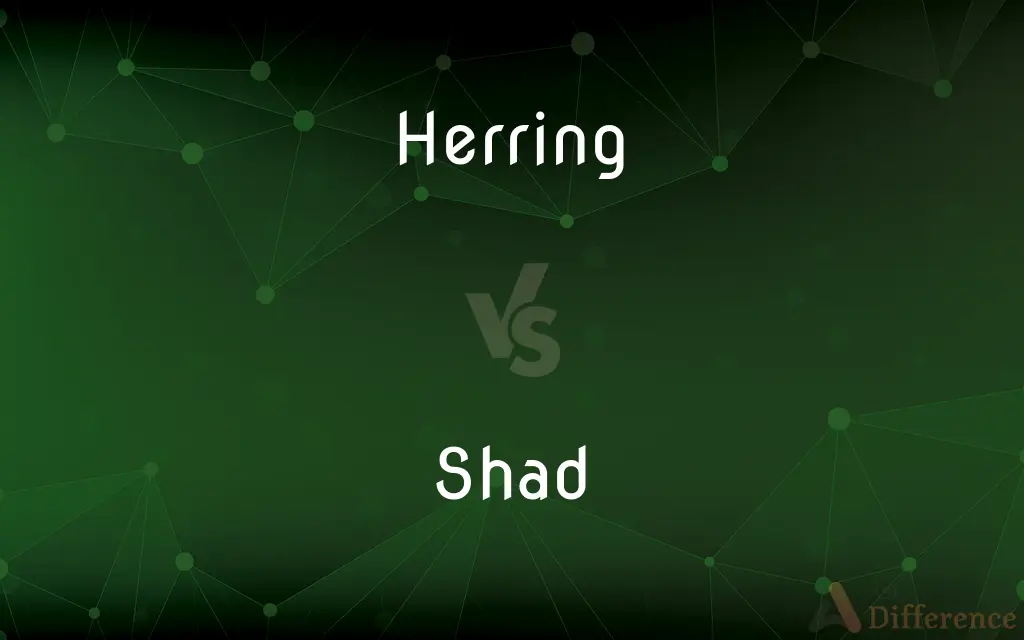Herring vs. Shad — What's the Difference?
By Urooj Arif & Fiza Rafique — Updated on March 26, 2024
Two oily fish, herring thrives in the cold waters of the North Atlantic, while shad are found in both the Atlantic and Pacific, migrating up rivers to spawn.

Difference Between Herring and Shad
Table of Contents
ADVERTISEMENT
Key Differences
Herring and shad are both oily fish, pivotal in their ecosystems and valued for their culinary uses, yet they inhabit different environments and have unique life cycles. Herring are primarily found in the cold waters of the North Atlantic and are known for their significant role in the marine food chain, serving as a crucial food source for a variety of predators. On the other hand, shad, specifically the American shad, are anadromous, spending most of their life in the ocean but migrating to freshwater rivers to spawn. They are found on both the Atlantic and Pacific coasts of North America and have a similar diet to herring but are unique for their extensive migrations.
Regarding culinary uses, herring is often consumed pickled, smoked, or salted, a reflection of traditional preservation methods that have become culinary delicacies in many cultures, particularly in Northern Europe. Herring is also processed into products like fish oil and meal. Shad, on the other hand, is celebrated for its delicate flesh when fresh and is particularly famous for its roe, considered a delicacy in some parts of the United States. The culinary traditions surrounding shad often involve grilling or smoking, especially during their spring spawning runs.
The fishing practices for herring and shad also differ, with herring being targeted on a larger industrial scale due to their abundance and the demand for their products worldwide. Shad fishing, while also commercial, tends to have a more localized and seasonal character, especially during the spawning runs when shad are more accessible in rivers and estuaries.
Conservation efforts for both species highlight the importance of sustainable fishing practices. Herring populations have been subject to overfishing, leading to the implementation of quotas and management plans to ensure their long-term viability. Similarly, shad populations have been affected by overfishing and habitat loss, particularly from dam construction that impedes their spawning migrations, prompting efforts to restore river habitats and improve fish passage.
In cultural significance, both herring and shad have played important roles. Herring has a long history in European maritime cultures, symbolizing prosperity and being celebrated in festivals and traditions. Shad runs are anticipated events in parts of the United States, marking the arrival of spring and celebrated through community gatherings and festivals that highlight the fish's culinary value.
ADVERTISEMENT
Comparison Chart
Habitat
Cold waters of the North Atlantic
Atlantic and Pacific, migrating to rivers for spawning
Culinary Uses
Pickled, smoked, salted; used in products like fish oil
Fresh, grilled, or smoked; roe is a delicacy
Fishing Practices
Targeted on a larger scale for industrial processing
Seasonal and localized, especially during spawning runs
Conservation
Subject to overfishing; managed through quotas
Affected by overfishing and habitat loss; efforts in habitat restoration
Cultural Significance
Symbolizes prosperity in European cultures; celebrated in festivals
Celebrated through community gatherings and festivals in the US
Compare with Definitions
Herring
Small, oily fish found in the North Atlantic.
Herring are key to the North Atlantic ecosystem, serving as a primary food source for larger predators.
Shad
Culinary value especially for its roe, which is considered a delicacy.
Shad roe is a seasonal delicacy in some parts of the United States.
Herring
Consumed in various forms including pickled and smoked.
Pickled herring is a traditional dish in many Northern European countries.
Shad
Anadromous fish found in the Atlantic and Pacific, spawning in freshwater rivers.
Every spring, shad migrate up rivers to spawn, a phenomenon eagerly anticipated by anglers.
Herring
Form large schools, making them efficient to catch on a large scale.
Fishing fleets often target herring schools for their economic value.
Shad
Fishing is more localized and tied to spawning seasons.
Shad fishing is a traditional spring activity in many river communities.
Herring
Subject to strict fishing quotas to prevent overfishing.
Herring populations are managed through quotas to ensure sustainability.
Shad
Conservation efforts focus on restoring river habitats for spawning.
Projects to remove or bypass dams are crucial for shad conservation.
Herring
Cultural importance in Europe, associated with prosperity.
In many European cultures, herring is celebrated in festivals and traditions.
Shad
Spring shad runs mark seasonal celebrations in American communities.
The arrival of shad is celebrated with community festivals in parts of the United States.
Herring
Herring are forage fish, mostly belonging to the family Clupeidae. Herring often move in large schools around fishing banks and near the coast, found particularly in shallow, temperate waters of the North Pacific and North Atlantic Oceans, including the Baltic Sea, as well as off the west coast of South America.
Shad
A herring-like fish that spends much of its life in the sea, typically entering rivers to spawn. It is an important food fish in many regions.
Herring
Any of various silvery fishes of the family Clupeidae, especially the commercially important Clupea harengus of the northern Atlantic Ocean and C. pallasii of the northern Pacific Ocean.
Shad
Any of several marine food fishes chiefly of the genus Alosa, especially A. sapidissima of northern North American waters, which swims up rivers to spawn. Shad are closely related to herring.
Herring
A type of small, oily fish of the genus Clupea, often used as food.
Shad
Any one of several species of food fishes that make up the genus Alosa in the family Clupeidae, to which the herrings also belong; river herring.
Herring
Fish in the family Clupeidae.
Shad
(South Africa) The bluefish (Pomatomus saltatrix).
Herring
Fish similar to those in genus Clupea, many of those in the order Clupeiformes.
Shad
Any one of several species of food fishes of the Herring family. The American species (Alosa sapidissima formerly Clupea sapidissima), which is abundant on the Atlantic coast and ascends the larger rivers in spring to spawn, is an important market fish. The European allice shad, or alose (Alosa alosa formerly Clupea alosa), and the twaite shad (Alosa finta formerly Clupea finta), are less important species.
Herring
One of various species of fishes of the genus Clupea, and allied genera, esp. the common round or English herring (Clupea harengus) of the North Atlantic. Herrings move in vast schools, coming in spring to the shores of Europe and America, where they are salted and smoked in great quantities.
Shad
Bony flesh of herring-like fish usually caught during their migration to fresh water for spawning; especially of Atlantic coast
Herring
Valuable flesh of fatty fish from shallow waters of northern Atlantic or Pacific; usually salted or pickled
Shad
Herring-like food fishes that migrate from the sea to freshwater to spawn
Herring
Commercially important food fish of northern waters of both Atlantic and Pacific
Common Curiosities
Why are herring important to the marine ecosystem?
Herring play a crucial role in the marine food chain, serving as a significant food source for a variety of marine predators.
Is overfishing a concern for both herring and shad?
Yes, overfishing has impacted both species, leading to conservation efforts and management plans to ensure their populations remain sustainable.
What distinguishes herring from shad?
Herring are primarily found in the cold waters of the North Atlantic and are known for their schooling behavior, while shad are anadromous, living in the ocean but spawning in freshwater rivers.
Can you eat shad roe?
Yes, shad roe is considered a delicacy in certain culinary traditions, especially in parts of the United States.
Do herring have any cultural significance?
Herring hold cultural importance in many European maritime cultures, symbolizing prosperity and celebrated through various traditions and festivals.
What is the difference in the fishing practices for herring and shad?
Herring fishing is conducted on a large scale for industrial processing, while shad fishing is more seasonal and focused on local markets, especially during spawning seasons.
Are herring and shad both considered oily fish?
Yes, both herring and shad are categorized as oily fish due to their high omega-3 fatty acids content.
What makes shad runs significant?
Shad runs mark the arrival of spring and are celebrated in some American communities through festivals and culinary events, highlighting the fish's seasonal availability and cultural value.
Are there conservation efforts for shad?
Yes, conservation efforts for shad focus on restoring their natural habitats, particularly river environments, to support their spawning migrations.
Do herring and shad have similar diets?
Both herring and shad feed on plankton, but their feeding habits and environments differ due to their unique life cycles.
How are shad and herring fished?
Herring are often targeted on a larger industrial scale, while shad fishing tends to be more localized and seasonal, particularly during their spawning runs.
How are herring processed for consumption?
Herring are processed in various ways, including pickling, smoking, and salting, reflecting traditional preservation techniques.
What challenges face shad populations?
Shad populations are challenged by overfishing and habitat loss, especially due to dams that block their spawning migrations.
Share Your Discovery

Previous Comparison
Lack vs. Lock
Next Comparison
Goaltender vs. GoalkeeperAuthor Spotlight
Written by
Urooj ArifUrooj is a skilled content writer at Ask Difference, known for her exceptional ability to simplify complex topics into engaging and informative content. With a passion for research and a flair for clear, concise writing, she consistently delivers articles that resonate with our diverse audience.
Co-written by
Fiza RafiqueFiza Rafique is a skilled content writer at AskDifference.com, where she meticulously refines and enhances written pieces. Drawing from her vast editorial expertise, Fiza ensures clarity, accuracy, and precision in every article. Passionate about language, she continually seeks to elevate the quality of content for readers worldwide.














































